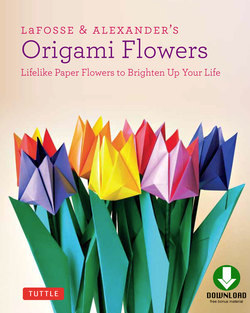Читать книгу LaFosse & Alexander's Origami Flowers Ebook - Michael G. LaFosse - Страница 9
На сайте Литреса книга снята с продажи.
ОглавлениеCategories of Origami Flowers
Flowers have long been favorite origami subjects because of their innate beauty, elegance, vivid colors, capacity to cheer, and symbolism. Origami flower designs span the full range of styles and techniques, and can be folded from nearly every type of paper, foil, and film. Whether folded small and in exacting detail, or constructed as huge assemblies for giant floral displays for retail store windows, origami flowers are guaranteed to dazzle and enchant.
Floral origami models may be just the blossom, or perhaps a blossom with accompanying calyx, or even the entire plant with leaves, stems and roots. Matthew Gardner, an origami designer, author, and folding friend of ours in Melbourne, Australia, has even created a window display featuring his robotic origami “flowers” that open and close, changing form and color based upon wireless prompts supplied by passersby!
These lilies (page 16) are beautiful examples of single sheet design.
Origami flower designs may be described in many ways. Here are some simple classifications.
Single sheet designs—Flower blossom or even an entire plant, always folded from one piece with no cuts and no glue. Highly complex designs may require a huge sheet
to produce a small model when the folding is complete.
This Rose for Irene (page 80) is an example of a single sheet design.
Multi-piece designs—Individual elements (such as petals or leaves) are folded and assembled—some styles use cleverly folded locking systems, and others need glue. These models often require small squares. Multi-piece designs are further defined by two sub-categories.
Modular—These designs are usually assembled from identically folded elements that are attached with folded tabs and pockets—not glue.
These Modular Blossoms (page 44) are an example of a modular multi-piece design.
Compound—These designs use components folded into different shapes, which are often assembled with glue.
This rose with leaves and stem is an example of a compound multi-piece design.
In the origami flower and plant universe, many blossoms have three, five, or six petals, so using non-square papers is not uncommon. Triangular, hexagonal, and pentagonal starting shapes have all been prescribed for greater folding efficiency, and long rectangular strips are commonly used to make leaves and stems.
